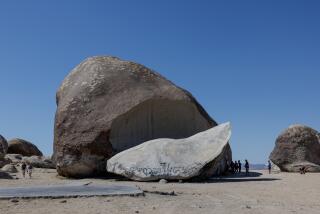Boom time in the Mojave
- Share via
“EEEEOOOWW!!” Geralynn topples over, cross-country skis and limbs tangled. Lisa and I, plodding forward in step-up-and-slide-down fashion, are catching up to her fast.
The rising summer solstice full moon illuminates the scene for what we -- me and friends Geralynn Felicetta and Lisa Tibolet, all of La Mesa -- are trying to accomplish: “skiing” on the summit ridge of Kelso Dunes, the second tallest in California.
No mere sand pile is this. The sand grains themselves are imbued with a special quality -- exceptional roundness, polish and uniformity -- that gives them a sonorous voice when they’re collectively sliding down the steepest dune slopes. The phenomenon, known as “booming” or “acoustic” sands -- more common in the Old World than the New -- has figured in folklore and travelers’ tales for 1,500 years, with the earliest references found in Chinese and Middle Eastern chronicles. Imaginative legends have spoken of the groaning of subterranean deities, of the incantations of ghosts and of the chiming of bells in a sand-drowned monastery.
In reality, the sound emanates from a peculiar vibration associated with sand flowing down the steeper face of certain rare dunes and sand drifts, of which Kelso Dunes is a relatively minor example.
Sand like this is known to sound off best in hot, dry weather, which explains the when and the why of our visit to the desert at a most unlikely time of year: June.
The next few weeks are sure to bring ideal day and night temperatures to this mid-elevation desert landscape, plus low-humidity conditions that will almost certainly make the sands boom best.
Geologists and physicists have studied and explained, hypothetically at least, the micro behavior of Kelso’s rolling and tumbling sand grains. But we’re here for the macro experience. On the summit ridge we see silvery linings on clouds drifting near the moon, and shadows of those same clouds creeping silently across square miles of empty Mojave Desert landscape.
Lisa squeezes into Geralynn’s ski boots, attaches herself to the skis and makes a smooth and silent run down a 45-degree slope into a bowl to the north, disappearing at length into a black moon shadow about a hundred yards down. Distant, giddy shrieks drift upward out of the darkness.
We finish with a wild and silly session of sliding three abreast down the steepest dune face we can find, elbow-deep in a languid river of warm sand. This is where we finally hear the dunes’ polyphonous bass melody and feel their tingling vibrations.
These days, the Kelso Dunes are acquiring a well-deserved reputation as a point of interest on maps of the Mojave National Preserve. The 1.4-million-acre, federally protected semi-wilderness sprawls across an almost unpopulated triangle of California bounded by Interstate 15, Interstate 40 and the Nevada border.
The hike to the top of the dunes involves more than a mile of tedious slogging in soft sand, then a final, gut-busting ascent on fluffy sand. Don’t forget to take plenty of water, or your throat will be as dry as those chattering sand grains.
*
The particulars
Where: Kelso Dunes in the Mojave National Preserve about 100 miles east of Barstow.
What: Moderate 1.2-mile hike across gently rolling sand dunes, then a brief, strenuous ascent of the main dune crest.
How: From Interstate 40, at a point 78 miles east of Barstow, take the Kelbaker Road exit. (Don’t miss that turnoff; the next exit is 22 miles away.) Follow Kelbaker Road north into Mojave National Preserve (no admission charge). After 13 miles, turn left on a marked gravel road leading 3 miles west to the Kelso Dunes trail head. Spartan restrooms and interpretive panels are here. Camping is allowed elsewhere in the national preserve, but not at this trail head.
Details: Mojave National Preserve, (760) 733-4040, www.nps.gov/moja.
*
Jerry Schad is author of “101 Hikes in Southern California.”
More to Read
Sign up for Essential California
The most important California stories and recommendations in your inbox every morning.
You may occasionally receive promotional content from the Los Angeles Times.













